An Intelligent Bio-Inspired Cooperative Decoupling Control Strategy for the Marine Boiler-Turbine System with a Novel Energy Dynamic Model
Abstract
:1. Introduction
2. Materials and Methods
2.1. Modeling of MBTS
2.1.1. Combustion and Heat Exchanging
2.1.2. The Main Steam Pressure
2.1.3. The Model of MSTP
2.1.4. The MBTS Coupling Model
2.2. Design of the IBICDC for the MBTS
2.2.1. The Control of the Steam Generation Process
2.2.2. Neuroendocrine Regulation Principles (NERP) in the Human Body
2.2.3. The Structure and Scheme of IBICDC
2.2.4. The Flexible Reference Trajectory (FRT) Scheme
N(k)=Φ2U+Γ2f23,0
3. Simulations Results and Discussion
4. Conclusions
Author Contributions
Funding
Conflicts of Interest
Appendix A
Appendix B

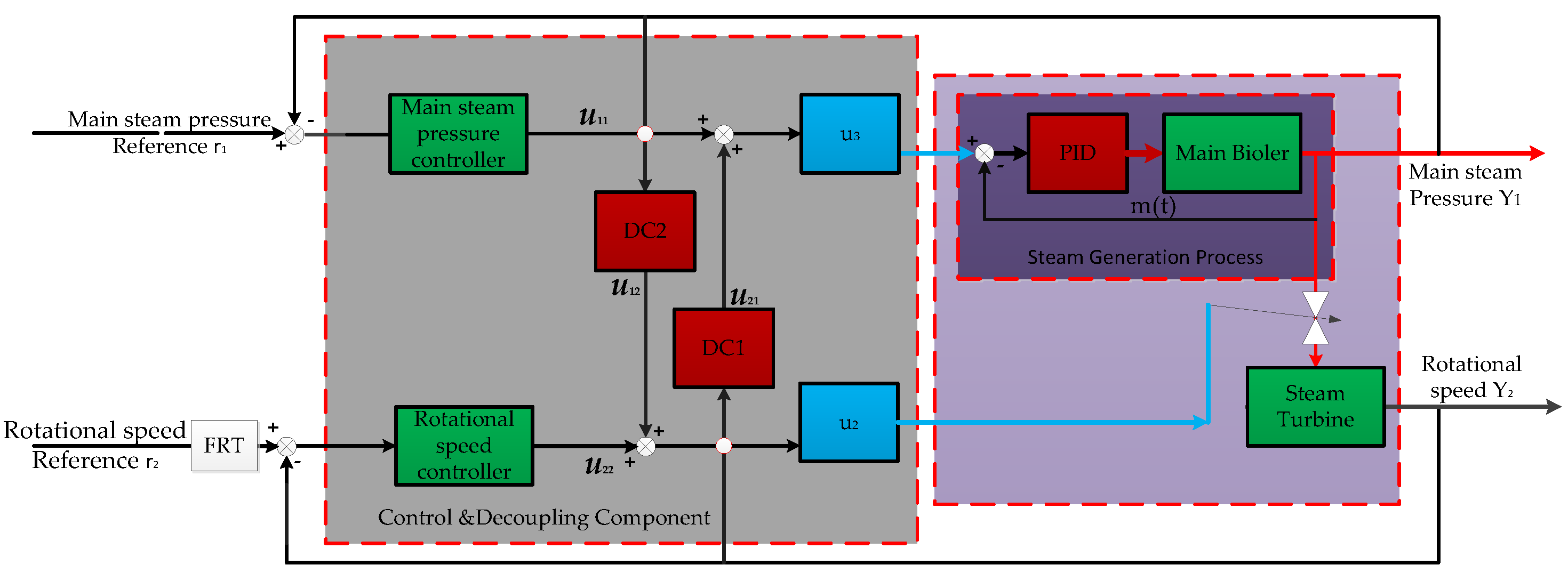

References
- Yu, T.; Chan, K.W.; Tong, J.P.; Zhou, B.; Li, D.H. Coordinated robust nonlinear boiler-turbine-generator control systems via approximate dynamic feedback linearization. J. Process Control 2010, 20, 365–374. [Google Scholar] [CrossRef]
- Bell, R.D.; Åström, K.J. Dynamics models for boiler-turbine alternator units: Data logs and parameter estimation for a 160 MW unit. Dept. Autom. Control Lund Inst. Technol. Lund Sweden Tech. Rep. 1987, 3192, 1–137. [Google Scholar]
- Åström, K.J.; Bell, R.D. Drum-boiler dynamics. Automatica 2000, 36, 363–378. [Google Scholar] [CrossRef]
- Wei, L.; Fang, F. H∞-LQR-Based Coordinated Control for Large Coal-Fired Boiler–Turbine Generation Units. IEEE Trans. Ind. Electron. 2017, 64, 5212–5221. [Google Scholar] [CrossRef]
- Maffezzoni, C. Boiler-turbine dynamics in power-plant control. Control Eng. Pract. 1997, 5, 301–312. [Google Scholar] [CrossRef]
- Goto, S.; Nakamura, M.; Matsumura, S. Automatic realization of human experience for controlling variable-pressure boilers. Control Eng. Pract. 2002, 10, 15–22. [Google Scholar] [CrossRef]
- Chai, T.Y.; Yue, H.; Bai, Y. Intelligent control of coal-pulverizing systems with ball-tube mill. In Proceedings of the IFAC 14th Triennial World Congress, Beijing, China, 11 September 1999; pp. 97–102. [Google Scholar]
- Liu, X.J.; Guan, P.; Chan, C.W. Nonlinear multivariable power plant coordinate control by constrained predictive scheme. IEEE Trans. Control Syst. Technol. 2010, 18, 1116–1125. [Google Scholar] [CrossRef]
- Chen, H.Y.; Ye, R.; Wang, X.D.; Lu, R.G. Cooperative Control of Power System Load and Frequency by Using Differential Games. IEEE Trans. Control Syst. Technol. 2015, 23, 882–897. [Google Scholar] [CrossRef]
- Alamoodi, N.; Daoutidis, P. Nonlinear Decoupling Control with Deadtime Compensation for Multirange Operation of Steam Power Plants. IEEE Trans. Control Syst. Technol. 2016, 24, 341–348. [Google Scholar] [CrossRef]
- Li, S.Y.; Liu, H.B.; Cai, W.J.; Soh, Y.-C.; Xie, L.H. A New Coordinated Control Strategy for Boiler-Turbine System of Coal-Fired Power Plant. IEEE Trans. Control Syst. Technol. 2005, 13, 943–955. [Google Scholar]
- Liu, H.B.; Li, S.Y.; Chai, T.Y. Intelligent decoupling control of power plant main steam pressure and power output. Int. J. Elect. Power Energy Syst. 2003, 25, 809–819. [Google Scholar] [CrossRef]
- Åström, K.J.; Eklund, K. A simple non-linear drum boiler model. Int. J. Control 1975, 22, 739–740. [Google Scholar] [CrossRef] [Green Version]
- U.S. Energy Information Administration. Annual Energy Outlook 2019 with projections to 2050; Energy Information Administration: Washington, DC, USA, 2019.
- Ding, Y.S.; Liang, X.; Hao, K.R.; Wang, H.P. An Intelligent Cooperative Decoupling Controller for Coagulation Bath in Polyacrylonitrile Carbon Fiber Production. IEEE Trans. Control Syst. Technol. 2013, 21, 467–479. [Google Scholar] [CrossRef]
- Falb, P.L.; Wolovich, W.A. Decoupling in design and synthesis of multivariable control systems. IEEE Trans. Autom. Control 1967, 12, 651–669. [Google Scholar] [CrossRef] [Green Version]
- Ghosh, A.; Das, S.K. Open-loop decoupling of MIMO plants. IEEE Trans. Autom. Control 2009, 54, 1977–1981. [Google Scholar] [CrossRef]
- Marino, R.; Cinili, F. Input-output decoupling control by measurement feedback in four-wheel-steering vehicles. IEEE Trans. Control Syst. Technol. 2009, 17, 1163–1172. [Google Scholar] [CrossRef]
- Michioka, C.; Sakamoto, T.; Ichikawa, O.; Chiba, A.; Fukao, T. A decoupling control method of reluctance-type bearingless motors considering magnetic saturation. IEEE Trans. Ind. Appl. 1996, 32, 1204–1210. [Google Scholar] [CrossRef]
- Chien, T.L.; Chen, C.C.; Huang, C.J. Feedback linearization control and its application to MIMO cancer immunotherapy. IEEE Trans. Control Syst. Technol. 2010, 18, 953–961. [Google Scholar] [CrossRef]
- Malabre, M.; Torres-Munoz, J.A. Block decoupling by precompensation revisited. IEEE Trans. Autom. Control 2007, 52, 922–925. [Google Scholar] [CrossRef]
- Lin, C.M.; Mon, Y.J. Decoupling control by hierarchical fuzzy sliding-mode controller. IEEE Trans. Control Syst. Technol. 2005, 13, 593–598. [Google Scholar] [CrossRef]
- Fu, Y.; Chai, T.Y. Intelligent decoupling control of nonlinear multivariable systems and its application to a wind tunnel system. IEEE Trans. Control Syst. Technol. 2009, 17, 1376–1384. [Google Scholar] [CrossRef]
- Chunghtai, S.S.; Wang, H. A high-integrity multivariable robust control with application to a process rig. IEEE Trans. Control Syst. Technol. 2007, 15, 775–785. [Google Scholar] [CrossRef]
- Zhang, J.; Chung, H.S.H.L.; Lo, W.L.; Hui, S.Y.; Wu, A.K.-M. Implementation of a decoupled optimization technique for design of switching regulators using genetic algorithms. IEEE Trans. Power Electron. 2001, 16, 752–763. [Google Scholar] [CrossRef]
- Rashed, M.; McConnell, P.F.A.; Stronach, A.F. Nonlinear adaptive state-feedback speed control of a voltage-fed induction motor with varying parameters. IEEE Trans. Ind. Appl. 2006, 42, 723–732. [Google Scholar] [CrossRef]
- Yu, D.L.; Chang, T.K.; Yu, D.W. A stable self-learning PID control for multivariable time varying systems. Control Eng. Pract. 2007, 15, 1577–1587. [Google Scholar] [CrossRef]
- Quan, Y.; Yang, J. Optimal decoupling control system using kernel method. J. Syst. Eng. Electron. 2004, 15, 364–370. [Google Scholar]
- Ding, Y.S.; Liu, B.; Ren, L.H. A decoupling controller based on the inverse control and the bi-regulation principle of growth hormone. Dyn. Contin. Discret. Impuls. Syst. Ser. B 2007, 14, 679–694. [Google Scholar]
- Ding, Y.S.; Liu, B. An intelligent bi-cooperative decoupling control approach based on modulation mechanism of internal environment in body. IEEE Trans. Control Syst. Technol. 2011, 19, 692–698. [Google Scholar] [CrossRef]
- Liu, B.; Ding, Y.S.; Wang, J.H. An intelligent controller inspired by bi-cooperative modulation mechanism. In Proceedings of the 2011 Seventh International Conference on Natural Computation, Shanghai, China, 26–28 July 2011; pp. 1711–1715. [Google Scholar]
- Wu, M.; Yan, J.; She, J.H.; Cao, W.H. Intelligent decoupling control of gas collection process of multiple asymmetric coke ovens. IEEE Trans. Ind. Electron. 2009, 56, 2782–2792. [Google Scholar]
- Martin, J.J.; Hou, Y.C. Development of an equation of state for gases. Aiche J. 1955, 1, 142–151. [Google Scholar] [CrossRef] [Green Version]
- The International Association for the Properties of Water and Steam. Release on the IAPWS Industrial Formulation 1997 for the Thermodynamic Properties of Water and Steam; The International Association for the Properties of Water and Steam: Erlangen, Germany, 1997. [Google Scholar]
- Tupper, E.C.; Rawson, K.J. Basic Ship Theory; Butterworth-Heinemann: Oxford, UK, 2001. [Google Scholar]
- Carlton, J.S. Marine Propellers and Propulsion; Butterworth–Heinemann: Oxford, UK, 1994. [Google Scholar]
- Peng, H.; Ozaki, T.; Haggan-Ozaki, V.; Toyoda, Y. A nonlinear exponential ARX model-based multivariable generalized predictive control strategy for thermal power plants. IEEE Trans. Control Syst. Technol. 2002, 10, 256–262. [Google Scholar] [CrossRef]
- Katebi, M.R.; Johnson, M.A. Predictive control design for large-scale systems. Automatica 1997, 33, 421–425. [Google Scholar] [CrossRef]
- Ordys, A.W.; Kock, P. Constrained predictive control for multivariable systems with application to power systems. Int. J. Robust Nonlinear Control 1999, 9, 781–797. [Google Scholar] [CrossRef]
- Prasad, G.; Swidenbank, E.; Hogg, B.W. A neural net model-based multivariable long-range predictive control strategy applied thermal power plant control. IEEE Trans. Energy Convers. 1998, 13, 176–182. [Google Scholar] [CrossRef]
- Schulkin, J. Allostasis, Homeostasis, and the Costs of Physiological Adaptation; Cambridge University Press: New York, NY, USA, 2004. [Google Scholar]
- Chen, G.R.; Trung, T.P. Introduction to Fuzzy Sets, Fuzzy Logic, and Fuzzy Control Systems; CRC Press: Boca Raton, FL, USA; London, UK; New York, NY, USA; Washington, DC, USA, 2000. [Google Scholar]
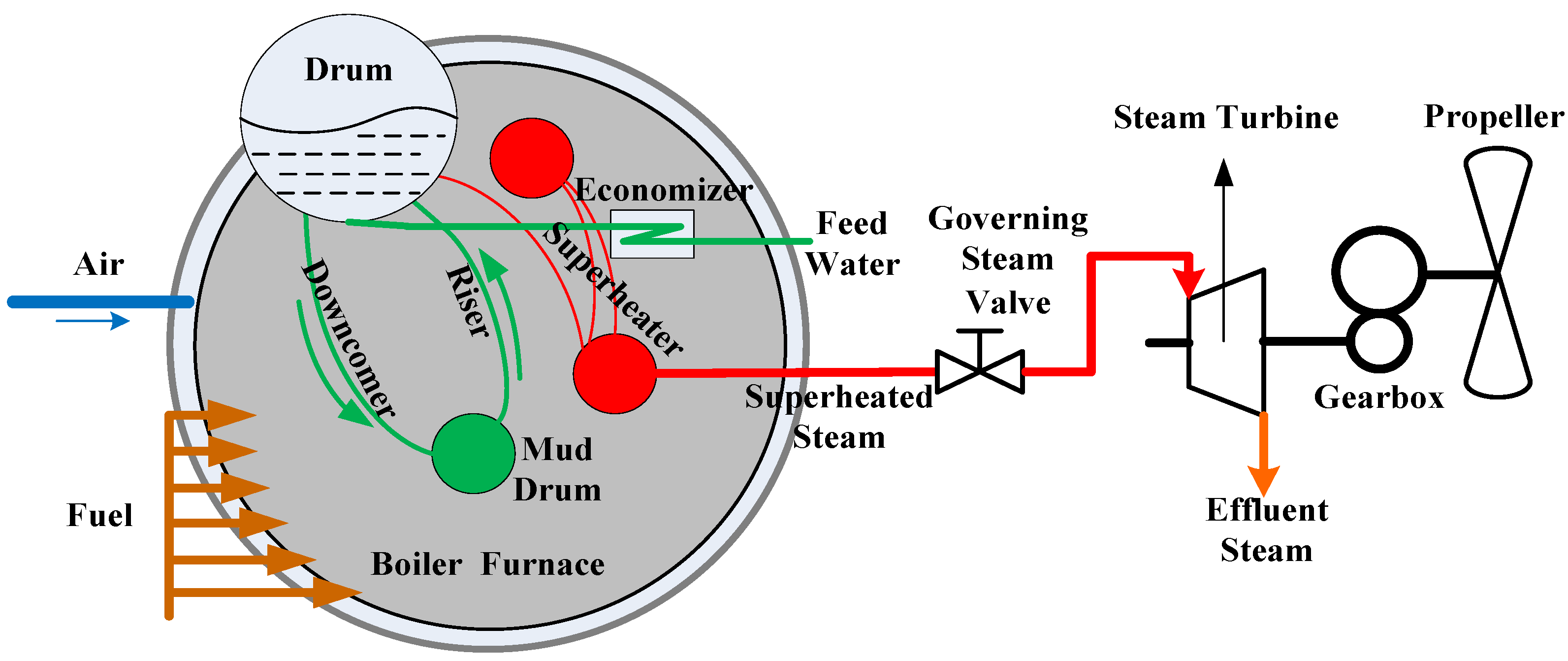


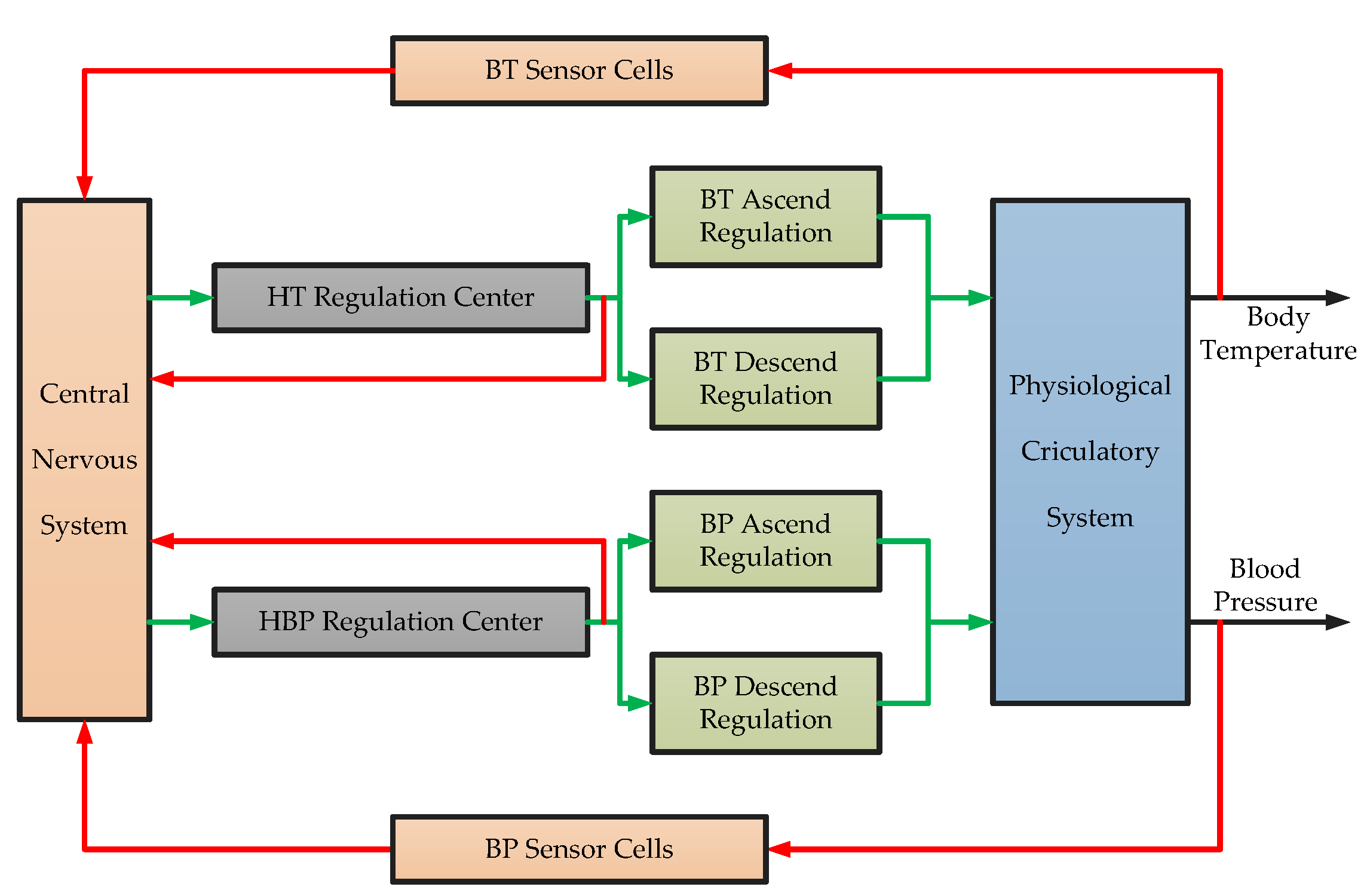
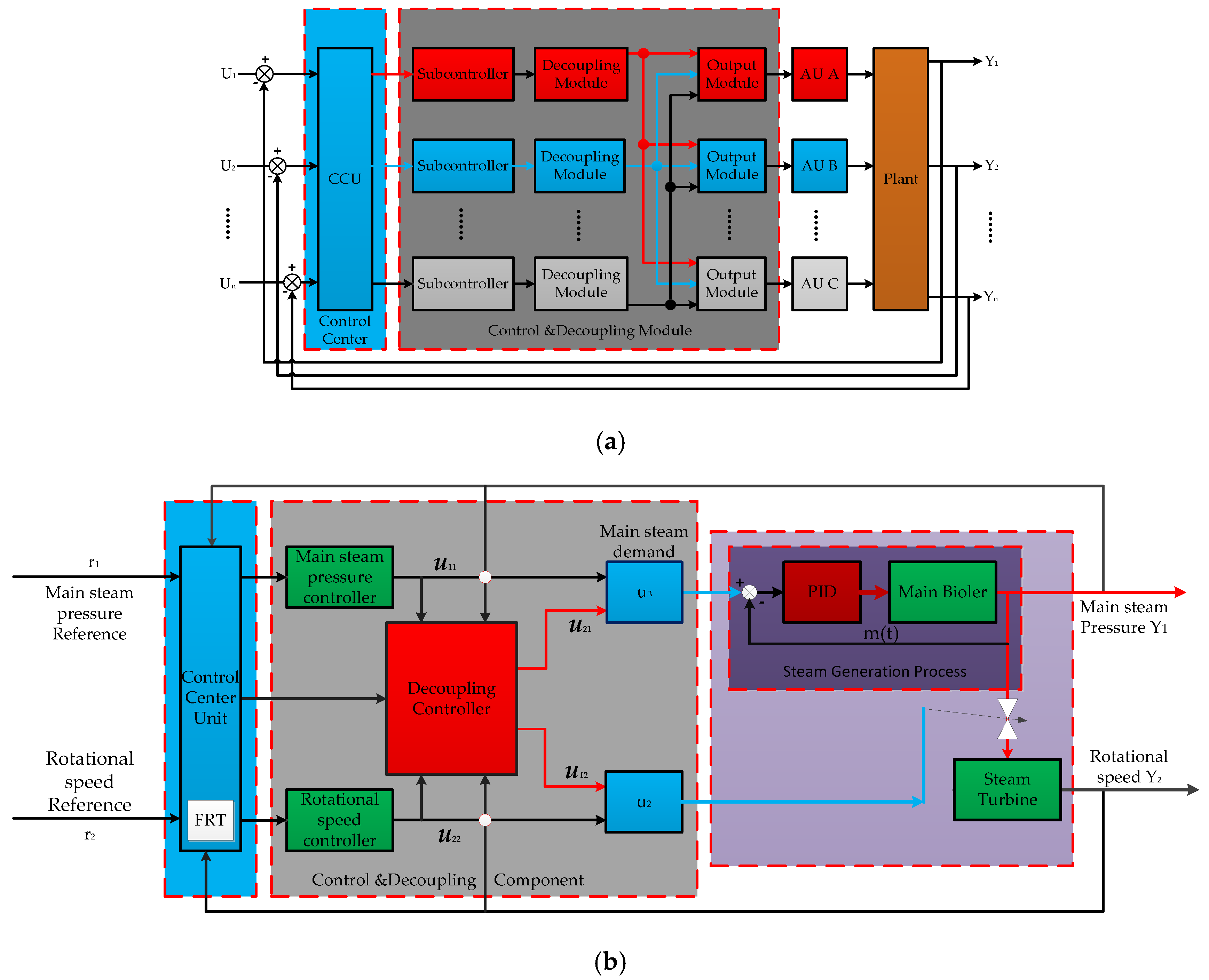



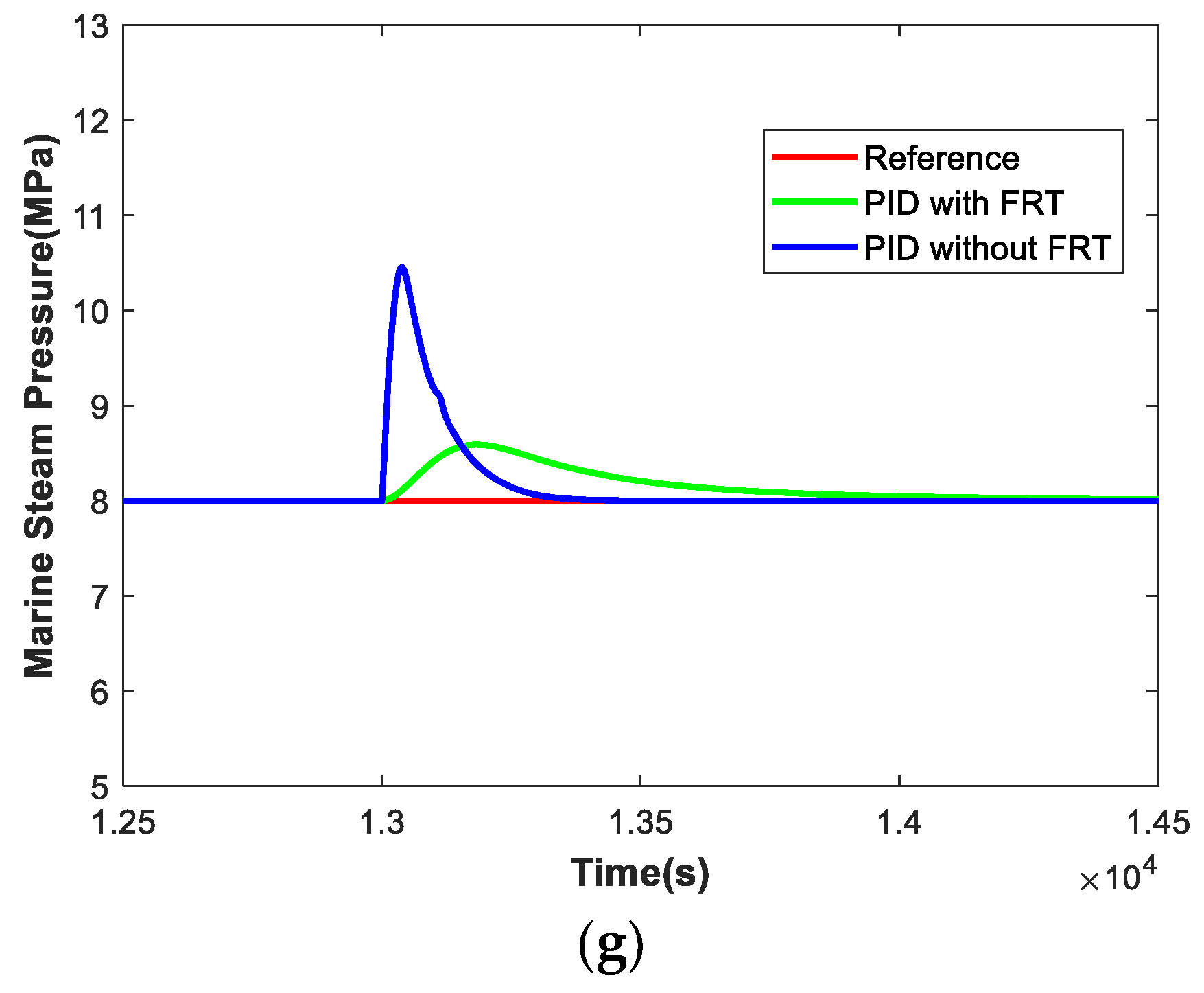

| Symbol | Value | SI-Unit |
|---|---|---|
| K1 | 17.0455 | — |
| T1 | 150 | s |
| T2 | 6 | s |
| Ts | 100 | s |
| kv | 300.5713 | — |
| c | 10.7801 | MPa/kg |
| Tsup | 529 | °C |
| J | 2304.3748 | kg·m2 |
| ρ | 1.0 × 103 | kg/m3 |
| a | 0.4 | |
| b | 0.6 | |
| a11 | 1 | |
| a12 | 1 | |
| a21 | 0.065 | |
| a22 | 0.065 | |
| d11 | 0.083 | |
| d12 | 0 | |
| d21 | 1 | |
| d22 | 0.0231 | |
| KP1 | 1.2992 | |
| KI1 | 0.01587 | |
| KD1 | 12.02301 | |
| KP2 | 0.001 | |
| KI2 | 4.7703 × 10-5 | |
| KD2 | 0.000011 |
© 2019 by the authors. Licensee MDPI, Basel, Switzerland. This article is an open access article distributed under the terms and conditions of the Creative Commons Attribution (CC BY) license (http://creativecommons.org/licenses/by/4.0/).
Share and Cite
Liu, S.; Zhao, B.; Zhao, S.; Zhang, L.; Wu, L. An Intelligent Bio-Inspired Cooperative Decoupling Control Strategy for the Marine Boiler-Turbine System with a Novel Energy Dynamic Model. Energies 2019, 12, 4659. https://doi.org/10.3390/en12244659
Liu S, Zhao B, Zhao S, Zhang L, Wu L. An Intelligent Bio-Inspired Cooperative Decoupling Control Strategy for the Marine Boiler-Turbine System with a Novel Energy Dynamic Model. Energies. 2019; 12(24):4659. https://doi.org/10.3390/en12244659
Chicago/Turabian StyleLiu, Sheng, Baoling Zhao, Shiquan Zhao, Lanyong Zhang, and Ling Wu. 2019. "An Intelligent Bio-Inspired Cooperative Decoupling Control Strategy for the Marine Boiler-Turbine System with a Novel Energy Dynamic Model" Energies 12, no. 24: 4659. https://doi.org/10.3390/en12244659







